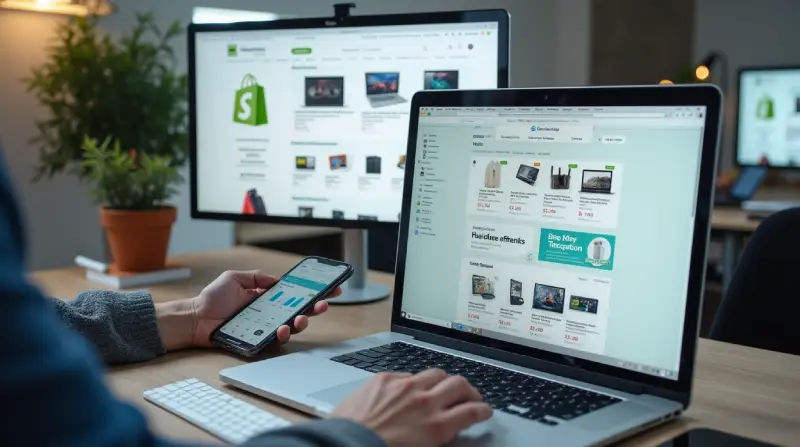Shopify Store Flipping: Strategies to Sell on Flippa
The digital entrepreneurship landscape has evolved dramatically in recent years, with eCommerce store flipping emerging as a lucrative business model. At its core, Shopify store flipping involves building or acquiring eCommerce stores, strategically enhancing their value, and selling them for profit on marketplaces like Flippa. This business model offers remarkable opportunities for entrepreneurs seeking low-overhead operations with substantial profit potential.
Flipping Shopify stores has gained tremendous popularity due to the growing demand for turnkey eCommerce solutions. Many entrepreneurs and investors are willing to pay premium prices for established stores that demonstrate revenue potential without requiring the initial setup work. This model is particularly attractive because it allows for multiple revenue streams – from quick flips of newer stores to significant paydays from well-established eCommerce operations. The appeal of store flipping lies in its flexibility and scalability. You can start with minimal investment, build a store around trending products or niches, optimize it for conversions and aesthetics, and sell it to eager buyers looking for ready-made businesses. As you gain experience, you can simultaneously work on multiple stores at different development stages, creating a sustainable business pipeline.
Table of Contents
Preparing Your Shopify Store for Sale
Preparing your Shopify store for sale is similar to preparing a house for the real estate market – presentation matters enormously. A well-prepared store can command significantly higher prices and attract more qualified buyers.
Store Documentation and Operations Manual
Comprehensive documentation is essential for a successful sale. Create a detailed operations manual that explains all aspects of running the store. Include information on supplier relationships, fulfillment processes, marketing strategies, and customer service protocols. Documenting standard operating procedures makes the store more valuable by demonstrating that the business can operate smoothly after changing hands.
Your documentation should include:
- Supplier contact information and ordering procedures
- Marketing channel performance data and strategies
- Customer support protocols and templates
- Technical information about store customizations
- Employee roles and responsibilities (if applicable)
Optimizing Store Metrics and Analytics
Buyers on Flippa are looking for concrete evidence of store performance. Clean up your analytics to present clear, accurate data about your store’s traffic, conversion rates, and customer acquisition costs. Install proper tracking for all marketing channels to demonstrate which traffic sources deliver the best ROI.
Focus on improving key performance indicators (KPIs) that buyers value most:
- Conversion rate optimization
- Average order value
- Customer lifetime value
- Cart abandonment rate
- Traffic growth trends
Visual Appeal and Brand Identity Enhancement
First impressions matter tremendously in store sales. Invest in professional design elements that create a cohesive brand identity. This includes high-quality product photography, a clean, modern store theme, and consistent visual branding across all customer touchpoints.
Consider hiring a professional designer to:
- Create an eye-catching logo and brand elements
- Implement a premium Shopify theme with customizations
- Design professional product pages with compelling visuals
- Develop branded email templates and marketing materials
A polished, professional-looking store gives buyers confidence in the business’s potential and justifies a higher asking price.

Valuing Your Shopify Store Correctly
One of the most challenging aspects of store flipping is determining an appropriate valuation. Price too high, and you’ll struggle to find buyers; price too low, and you’ll leave money on the table.
Valuation Methods and Multiples
The industry standard for eCommerce store valuation typically ranges from 2-4x annual profits for established stores with consistent revenue. However, valuation multiples can vary significantly based on several factors:
- Revenue Multiple: Typically 0.5-2x annual revenue
- Profit Multiple: Usually 2-4x annual profit for established stores
- Assets-Based Valuation: Considering inventory, custom development, and digital assets
For newer stores with limited history, valuations may focus more on assets and potential rather than historical performance. In these cases, consider factors like:
- Quality and value of inventory
- Custom development work and theme customizations
- Email list size and quality
- Social media following and engagement metrics
- Domain authority and SEO rankings
Highlighting Growth Potential and Opportunities
Buyers aren’t just purchasing your store’s current performance; they’re investing in its future potential. Clearly articulate untapped opportunities that the new owner could leverage to grow the business further.
Document specific growth opportunities like:
- Expansion into new geographic markets
- Additional product lines or categories
- Underdeveloped marketing channels
- Potential for subscription models or recurring revenue
- Opportunities for strategic partnerships
Provide data-backed projections showing potential returns on these opportunities to make your store more appealing to growth-minded buyers.
Case Studies of Successful Store Valuations
Learning from successful sales can provide valuable insights for your own valuation strategy. For example, a dropshipping store in the pet niche with $5,000 monthly revenue and $2,000 monthly profit might sell for $15,000-$24,000 (approximately 8-12x monthly profit).
Factors that positively influenced valuations in successful case studies include:
- Consistent monthly growth over 6+ months
- Diverse traffic sources not overly dependent on paid advertising
- Unique products or exclusive supplier relationships
- Strong brand identity and customer loyalty
- Automated operations requiring minimal time investment
Creating a Compelling Flippa Listing
Your Flippa listing is essentially your sales page – it needs to capture attention, build trust, and motivate action from potential buyers.
Crafting an Attention-Grabbing Title and Description
Your listing title should be concise yet compelling, highlighting the most attractive aspects of your store. Include key information like niche, revenue figures, and unique selling points. For example: “Established Pet Accessories Shopify Store – $5K Monthly Revenue, 40% Profit Margins, 2 Years in Business.”
In your description, start with a strong executive summary that outlines the business model, key performance metrics, and unique advantages. Then structure the remaining description logically, covering:
- Business overview and history
- Revenue and profit breakdown
- Traffic sources and marketing strategies
- Operations and time requirements
- Reason for selling (be honest but strategic)
- Growth opportunities for new owners
Showcasing Financial Data and Performance Metrics
Transparency about financial performance builds trust with serious buyers. Provide detailed but easy-to-understand financial information:
- Monthly revenue and profit for at least the past 12 months
- Breakdown of expenses (COGS, marketing, platform fees, etc.)
- Seasonal trends and explanations for any anomalies
- Traffic analytics with conversion rates
- Customer acquisition costs and lifetime value
Use visual elements like charts or graphs to make financial data more digestible. Consider creating a separate financial document with more detailed information that can be shared with qualified buyers after they sign an NDA.
Using Visual Assets to Enhance Your Listing
Visual elements significantly increase engagement with your listing. Include:
- Store screenshots showing design and functionality
- Backend screenshots demonstrating traffic and sales data
- Product images highlighting your inventory
- Video walkthrough of the store’s operation
- Charts and graphs visualizing growth trends
Professional-quality visuals signal to buyers that you’ve invested in the business and take the sale seriously. This perception of professionalism can justify higher asking prices.
Negotiating and Closing the Sale Successfully
Once your listing attracts interested buyers, strong negotiation skills become essential for maximizing your sale price and ensuring a smooth transaction.
Screening Potential Buyers Effectively
Not all inquiries are equal – focus your time and energy on qualified buyers who have both the means and genuine interest to complete the purchase. Develop a screening process that includes:
- Initial questionnaire about their experience and investment capacity
- Verification of funds or proof of ability to purchase
- Non-disclosure agreement before sharing sensitive details
- Video call to assess seriousness and answer questions
This screening process not only saves time but also creates a sense of exclusivity that can drive up perceived value.

Structuring Deals for Maximum Value
Consider offering flexible deal structures that can accommodate different buyer preferences while maximizing your returns:
- All-cash deals for clean, simple transactions
- Partial seller financing for higher overall valuations
- Earn-out structures based on future performance
- Consulting retainer for post-sale support
- Equity retention options for particularly promising stores
Being flexible with deal structure can often lead to higher total value than insisting on specific terms. Focus on your priorities (whether that’s maximum upfront cash, total long-term value, or quick closing) and negotiate accordingly.
| Deal Structure | Pros | Cons | Best For |
| All-Cash | Immediate payout, clean break | Typically lower valuation | Sellers needing quick liquidity |
| Seller Financing | Higher valuation, monthly income | Risk if buyer defaults | Established stores with stable history |
| Earn-Out | Highest potential valuation | Payment uncertainty, continued involvement | High-growth stores with untapped potential |
| Hybrid (Cash + Earn-Out) | Balanced risk/reward, partial upfront payment | Complexity in structuring | Most medium-sized store sales |
| Equity Retention | Ongoing participation in upside | Continued responsibility without control | Unique stores with exceptional growth potential |
Post-Sale Transition and Support
A smooth transition is crucial for successful store flipping. Well-planned handover procedures protect your reputation and can lead to positive reviews, referrals, and potentially repeat business from the same buyer.
Develop a comprehensive transition plan covering:
- Access transfer for all platforms and tools
- Supplier introductions and relationship handoff
- Customer service training and knowledge transfer
- Marketing strategy documentation and training
- Technical support during the initial transition period
Consider offering tiered support packages as upsells during negotiation. For example, basic email support for 2 weeks might be included, with options for extended support at additional cost.
Frequently Asked Questions
How long does it typically take to sell a Shopify store on Flippa?
The timeline varies significantly based on store quality, pricing, and market conditions. Well-priced, properly prepared stores with good documentation can sell within 2-4 weeks. Stores with unrealistic valuations or poor preparation may take months or never sell. The average time from listing to completed sale is approximately 30-45 days.
What documentation do I need to prepare before listing my store?
Essential documentation includes at least 12 months of financial statements, analytics data showing traffic sources and conversion rates, supplier agreements, operations manuals, and inventory lists. Additionally, prepare documentation on any proprietary processes, custom development work, and growth strategies that add value to the business.
Should I mention why I’m selling my store?
Yes, but frame it strategically. Buyers are naturally suspicious about sellers’ motivations. Common acceptable reasons include portfolio diversification, focusing on other projects, or life changes requiring time reallocation. Avoid reasons that suggest the business has fundamental problems or limited future potential.
How can I verify if a buyer is serious?
Implement a multi-step qualification process. Start with basic questions about their experience and investment capacity. Require a signed NDA before sharing detailed financials. For serious prospects, schedule a video call and discuss their vision for the business. Serious buyers ask detailed, thoughtful questions about operations and growth potential rather than focusing solely on trying to negotiate the price down.
What can I do if my store doesn’t sell initially?
If your store doesn’t attract buyers within 30 days, reassess your pricing strategy and listing quality. Consider temporarily removing the listing and making improvements based on feedback received. Focus on enhancing store metrics, improving documentation, or developing new revenue streams before relisting. Alternatively, consider working with a broker who specializes in eCommerce businesses to tap into their network of qualified buyers.
Is it better to build a new store or buy an existing one to flip?
Both approaches have merit depending on your skills and resources. Building from scratch offers maximum profit potential but requires more time and skill in store development. Buying existing stores to improve and flip offers faster turnaround but requires more upfront capital. Many successful flippers eventually do both: building new stores in promising niches while simultaneously acquiring undervalued stores to optimize and resell.







